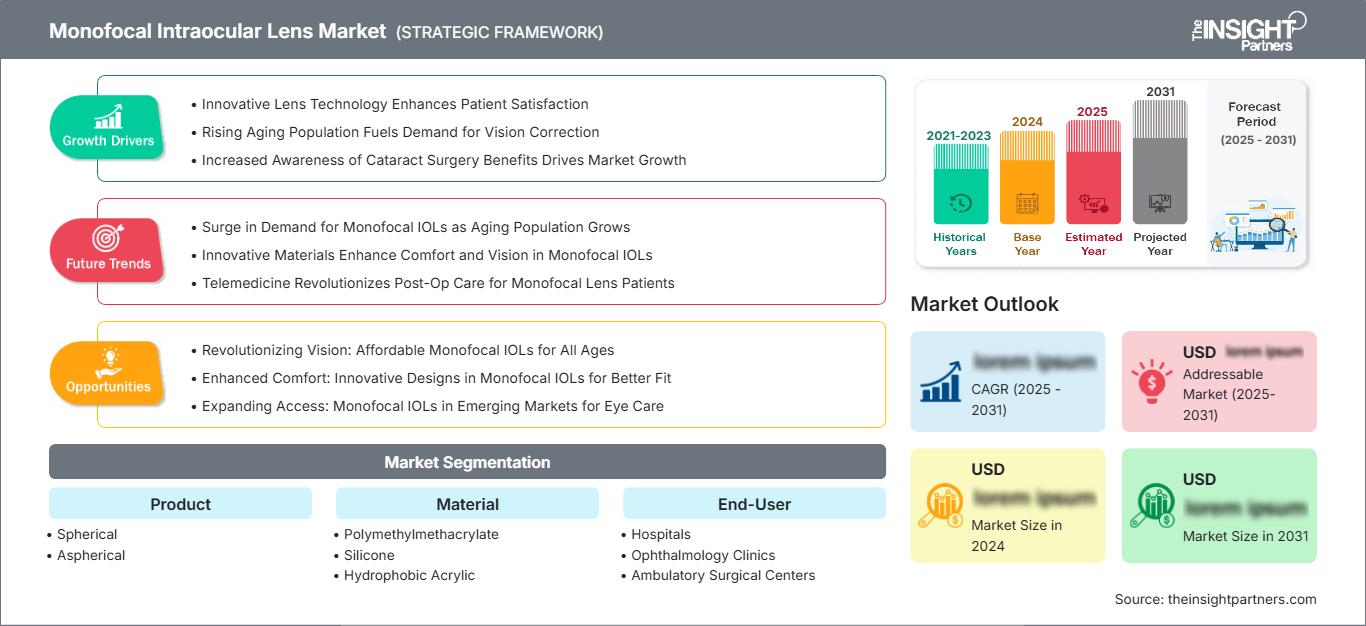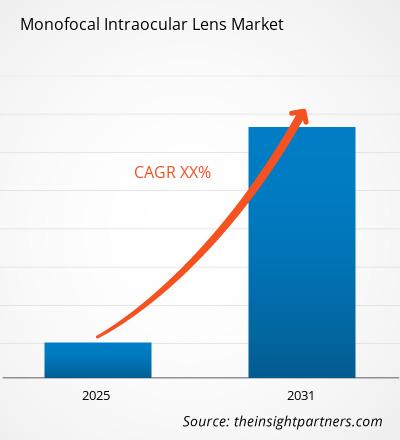Si prevede che il mercato delle lenti intraoculari monofocali registrerà una crescita costante dal 2026 al 2034, con una valutazione prevista in crescita rispetto al valore di riferimento del 2025 e in continua espansione fino alla fine del periodo di previsione. Questa tendenza riflette una prospettiva di mercato favorevole, guidata dall'evoluzione dei requisiti del settore e dai continui progressi tecnologici.
Il rapporto è suddiviso per prodotto (sferico, asferico) e analizza ulteriormente il mercato in base al materiale (polimetilmetacrilato, silicone, acrilico idrofobo). Esamina inoltre il mercato per utente finale (ospedali, cliniche oftalmologiche, centri chirurgici ambulatoriali). Per ciascuno di questi segmenti chiave viene fornita una ripartizione completa a livello globale, regionale e nazionale. Il rapporto include le dimensioni del mercato e le previsioni per tutti i segmenti, presentando i valori in USD. Fornisce inoltre statistiche chiave sullo stato attuale del mercato dei principali attori, insieme ad approfondimenti sulle tendenze prevalenti e sulle opportunità emergenti.
Scopo del rapporto
Il rapporto "Monofocal Intraocular Lens Market" di The Insight Partners mira a descrivere il panorama attuale e la crescita futura, i principali fattori trainanti, le sfide e le opportunità. Ciò fornirà spunti a vari stakeholder aziendali, come:
- Fornitori/Produttori di tecnologia: per comprendere le dinamiche di mercato in evoluzione e conoscere le potenziali opportunità di crescita, consentendo loro di prendere decisioni strategiche informate.
- Investitori: per condurre un'analisi completa delle tendenze in merito al tasso di crescita del mercato, alle proiezioni finanziarie di mercato e alle opportunità esistenti lungo la catena del valore.
- Enti di regolamentazione: per regolamentare le politiche e le attività di controllo sul mercato con l'obiettivo di ridurre al minimo gli abusi, preservare la fiducia degli investitori e sostenere l'integrità e la stabilità del mercato.
Segmentazione del mercato delle lenti intraoculari monofocali Prodotto
- Sferiche
- Asferiche
Materiali
- Polimetilmetacrilato
- Silicone
- Acrilico idrofobico
Utente finale
- Ospedali
- Cliniche oftalmologiche
- Centri chirurgici ambulatoriali
Potrai personalizzare gratuitamente qualsiasi rapporto, comprese parti di questo rapporto, o analisi a livello di paese, pacchetto dati Excel, oltre a usufruire di grandi offerte e sconti per start-up e università
Mercato delle lenti intraoculari monofocali: Approfondimenti strategici

-
Ottieni le principali tendenze chiave del mercato di questo rapporto.Questo campione GRATUITO includerà l'analisi dei dati, che vanno dalle tendenze di mercato alle stime e alle previsioni.
Fattori di crescita del mercato delle lenti intraoculari monofocali
- La tecnologia innovativa delle lenti aumenta la soddisfazione del paziente
- L'invecchiamento della popolazione alimenta la domanda di correzione della vista
- La maggiore consapevolezza dei benefici della chirurgia della cataratta stimola la crescita del mercato
Tendenze future del mercato delle lenti intraoculari monofocali
- Aumento della domanda di IOL monofocali con l'invecchiamento della popolazione
- I materiali innovativi migliorano il comfort e la vista nelle IOL monofocali
- La telemedicina rivoluziona l'assistenza post-operatoria per i pazienti con lenti monofocali
Opportunità di mercato per le lenti intraoculari monofocali
- Rivoluzionare la vista: IOL monofocali convenienti per tutte le età
- Maggiore comfort: Design innovativi nelle IOL monofocali per una migliore vestibilità
- Ampliamento dell'accesso: IOL monofocali nei mercati emergenti per la cura degli occhi
Mercato delle lenti intraoculari monofocali
Le tendenze regionali e i fattori che influenzano il mercato delle lenti intraoculari monofocali durante il periodo di previsione sono stati ampiamente spiegati dagli analisti di The Insight Partners. Questa sezione illustra anche i segmenti di mercato e la distribuzione geografica della gestione delle malattie del ritmo cardiaco in Nord America, Europa, Asia-Pacifico, Medio Oriente e Africa, America meridionale e centrale.
Mercato delle lenti intraoculari monofocali Report Scope
| Attributo del rapporto | Dettagli |
|---|---|
| Dimensioni del mercato in 2025 | US$ XX Million |
| Dimensioni del mercato per 2034 | US$ XX Million |
| CAGR globale (2026 - 2034) | XX% |
| Dati storici | 2021-2024 |
| Periodo di previsione | 2026-2034 |
| Segmenti coperti |
By Prodotto
|
| Regioni e paesi coperti |
Nord America
|
| Leader di mercato e profili aziendali chiave |
|
Densità degli operatori del mercato delle lenti intraoculari monofocali: comprendere il suo impatto sulle dinamiche aziendali
Il mercato delle lenti intraoculari monofocali è in rapida crescita, trainato dalla crescente domanda da parte degli utenti finali, dovuta a fattori quali l'evoluzione delle preferenze dei consumatori, i progressi tecnologici e una maggiore consapevolezza dei benefici del prodotto. Con l'aumento della domanda, le aziende stanno ampliando la propria offerta, innovando per soddisfare le esigenze dei consumatori e sfruttando le tendenze emergenti, alimentando ulteriormente la crescita del mercato.

- Ottieni il Mercato delle lenti intraoculari monofocali Panoramica dei principali attori chiave
Punti di forza
- Copertura completa: il rapporto analizza in modo esaustivo prodotti, servizi, tipologie e utenti finali del mercato delle lenti intraoculari monofocali, fornendo un panorama olistico.
- Analisi degli esperti: il rapporto è redatto sulla base della conoscenza approfondita di esperti e analisti del settore.
- Informazioni aggiornate: il rapporto garantisce la pertinenza aziendale grazie alla copertura di informazioni e tendenze dei dati recenti.
- Opzioni di personalizzazione: questo rapporto può essere personalizzato per soddisfare le esigenze specifiche del cliente e adattarsi in modo appropriato alle strategie aziendali.
Il rapporto di ricerca sul mercato delle lenti intraoculari monofocali può quindi aiutare a guidare il percorso di decodificazione e comprensione dello scenario del settore e delle prospettive di crescita. Sebbene possano esserci alcune preoccupazioni valide, i vantaggi complessivi di questo rapporto tendono a superare gli svantaggi.
- Analisi storica (2 anni), anno base, previsione (7 anni) con CAGR
- Analisi PEST e SWOT
- Valore/volume delle dimensioni del mercato - Globale, Regionale, Nazionale
- Industria e panorama competitivo
- Set di dati Excel
Report recenti
Testimonianze
Motivo dell'acquisto
- Processo decisionale informato
- Comprensione delle dinamiche di mercato
- Analisi competitiva
- Analisi dei clienti
- Previsioni di mercato
- Mitigazione del rischio
- Pianificazione strategica
- Giustificazione degli investimenti
- Identificazione dei mercati emergenti
- Miglioramento delle strategie di marketing
- Aumento dell'efficienza operativa
- Allineamento alle tendenze normative






















 Ottieni un campione gratuito per - Mercato delle lenti intraoculari monofocali
Ottieni un campione gratuito per - Mercato delle lenti intraoculari monofocali